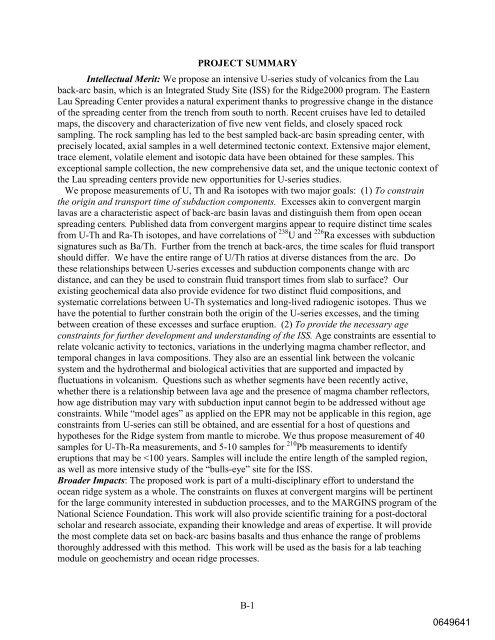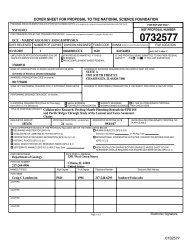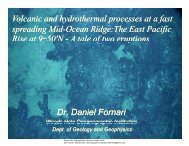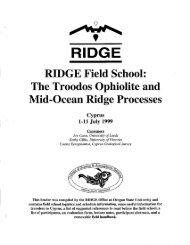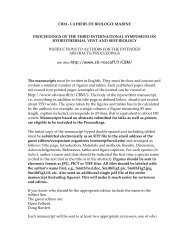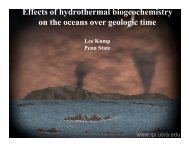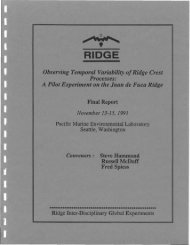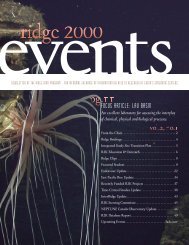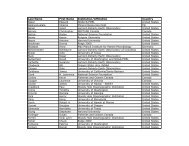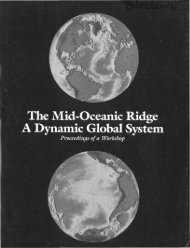NSF Forms - Ridge 2000 Program
NSF Forms - Ridge 2000 Program
NSF Forms - Ridge 2000 Program
Create successful ePaper yourself
Turn your PDF publications into a flip-book with our unique Google optimized e-Paper software.
PROJECT SUMMARY<br />
Intellectual Merit: We propose an intensive U-series study of volcanics from the Lau<br />
back-arc basin, which is an Integrated Study Site (ISS) for the <strong>Ridge</strong><strong>2000</strong> program. The Eastern<br />
Lau Spreading Center provides a natural experiment thanks to progressive change in the distance<br />
of the spreading center from the trench from south to north. Recent cruises have led to detailed<br />
maps, the discovery and characterization of five new vent fields, and closely spaced rock<br />
sampling. The rock sampling has led to the best sampled back-arc basin spreading center, with<br />
precisely located, axial samples in a well determined tectonic context. Extensive major element,<br />
trace element, volatile element and isotopic data have been obtained for these samples. This<br />
exceptional sample collection, the new comprehensive data set, and the unique tectonic context of<br />
the Lau spreading centers provide new opportunities for U-series studies.<br />
We propose measurements of U, Th and Ra isotopes with two major goals: (1) To constrain<br />
the origin and transport time of subduction components. Excesses akin to convergent margin<br />
lavas are a characteristic aspect of back-arc basin lavas and distinguish them from open ocean<br />
spreading centers. Published data from convergent margins appear to require distinct time scales<br />
from U-Th and Ra-Th isotopes, and have correlations of 238 U and 226 Ra excesses with subduction<br />
signatures such as Ba/Th. Further from the trench at back-arcs, the time scales for fluid transport<br />
should differ. We have the entire range of U/Th ratios at diverse distances from the arc. Do<br />
these relationships between U-series excesses and subduction components change with arc<br />
distance, and can they be used to constrain fluid transport times from slab to surface? Our<br />
existing geochemical data also provide evidence for two distinct fluid compositions, and<br />
systematic correlations between U-Th systematics and long-lived radiogenic isotopes. Thus we<br />
have the potential to further constrain both the origin of the U-series excesses, and the timing<br />
between creation of these excesses and surface eruption. (2) To provide the necessary age<br />
constraints for further development and understanding of the ISS. Age constraints are essential to<br />
relate volcanic activity to tectonics, variations in the underlying magma chamber reflector, and<br />
temporal changes in lava compositions. They also are an essential link between the volcanic<br />
system and the hydrothermal and biological activities that are supported and impacted by<br />
fluctuations in volcanism. Questions such as whether segments have been recently active,<br />
whether there is a relationship between lava age and the presence of magma chamber reflectors,<br />
how age distribution may vary with subduction input cannot begin to be addressed without age<br />
constraints. While “model ages” as applied on the EPR may not be applicable in this region, age<br />
constraints from U-series can still be obtained, and are essential for a host of questions and<br />
hypotheses for the <strong>Ridge</strong> system from mantle to microbe. We thus propose measurement of 40<br />
samples for U-Th-Ra measurements, and 5-10 samples for 210 Pb measurements to identify<br />
eruptions that may be


